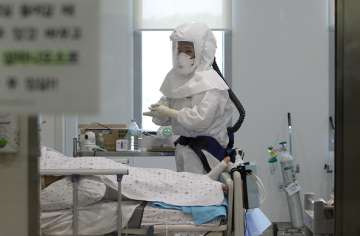Seoul, South Korea: A new study, which tracks the transmission of first outbreak of the deadly virus Middle East Respiratory Syndrome (MERS), claims that a single “super-spreader” patient in an overcrowded hospital emergency department transmitted the MERS virus to 82 people in just three days.
Tracing the movements of patients at a South Korean hospital has helped identify the case of highest transmission Middle East Respiratory Syndrome (MERS) virus from a single patient outside the Middle East.
Since it was first identified in 2012, of MERS Coronavirus (MERS-CoV) has spread to 27 countries. Patients develop severe acute respiratory illness with symptoms of fever, cough and shortness of breath.
About 3-4 out of every 10 patients reported with MERS-CoV have died, most of whom had an underlying medical condition. Previous studies have suggested that the potential for MERS-CoV to spread to large numbers of people was low.
In between May and July last year, there was a MERS-CoV outbreak in South Korea, where 186 cases were confirmed within two months.
The 'index patient' (where the outbreak originated) was a man aged 68, otherwise known as Patient 1, who had travelled to Bahrain, the UAE, Saudi Arabia and Qatar between 18 April and 3 May last year, before returning to South Korea. He first visited the Samsung Medical Centre in Seoul on 17 May, and was isolated on 18 May under the suspicion of MERS and finally diagnosed with MERS on 20 May.
However, before arriving at Samsung Medical Centre, Patient 1 had already transmitted the virus to several individuals in other hospitals, including another man (Patient 14), aged 35 with whom he shared a ward.
Patient 14 was admitted to Samsung Medical Center with no information on possible exposure to MERS-CoV on 27 May - and it was this patient who led to the hospital outbreak.
The research team did a retrospective investigation of the outbreak at the hospital, including a review of closed-circuit security video footage and electronic medical records.
A total of 1,576 people were estimated to have been exposed to Patient 14 in the emergency room and a total of 82 people - 33 patients, 8 health-care workers, and 41 visitors - were infected between 27-29 May.
There were no confirmed cases of patients or visitors who visited the emergency room on 29 May, after Patient 14 had been isolated.
In contrast, Patient 1 was in contact with 285 other patients and 193 health-care workers but no further transmissions occurred at the hospital between presenting to the emergency room on 17 May and being isolated on 18 May.
However, Patient 1 had previously infected 28 other patients in another hospital.
The difference in transmissibility between Patient 1 and Patient 14 could be caused by many factors such as time from onset of disease, symptoms, duration of contact, pattern of movement and the spread of the virus itself, researchers said. The study was published in the journal Lancet.
(With PTI inputs)
Latest World News

